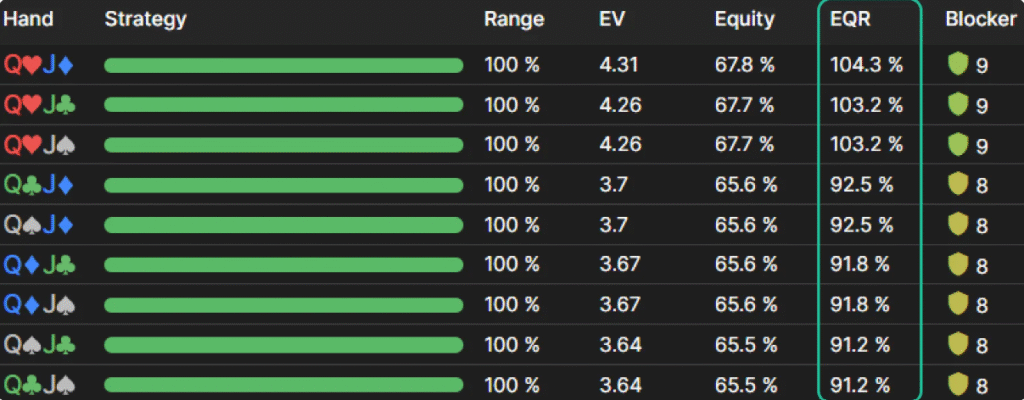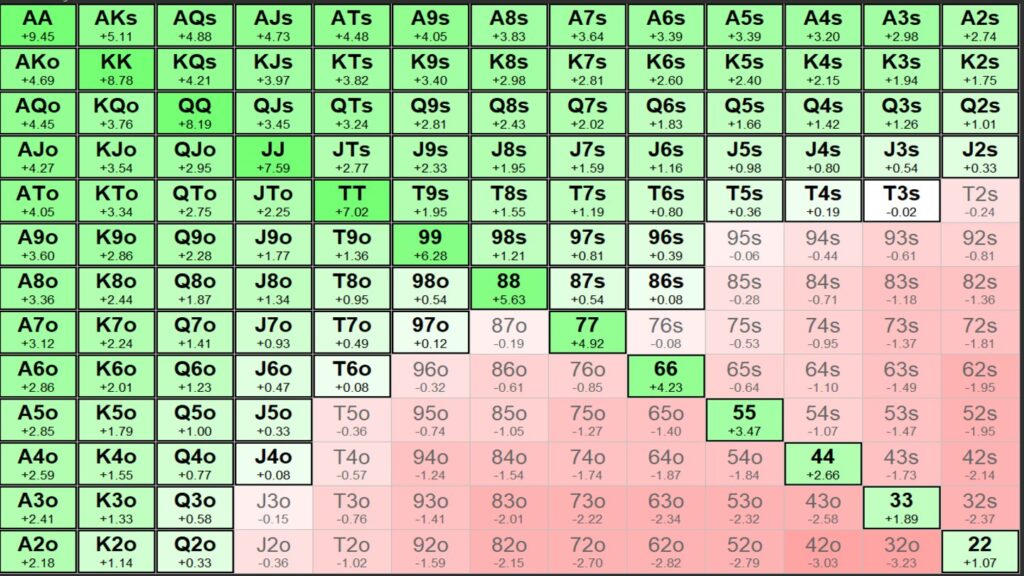Before you can call yourself a successful poker player, you must understand the basic mathematical concepts behind the game.
One of the most basic mathematical concepts in poker is poker equity, which is a representation of the share of the pot that belongs to you.
In every poker hand you ever play, you will have some amount of equity to start with, and this amount will change with every new card dealt.
In this guide, we will explain what poker equity is, how to calculate it, and how to apply your understanding of poker equity in-game. Let’s begin.
Poker Equity Explained
In the simplest of terms, poker equity is a mathematical representation of the chunk of the pot that theoretically belongs to you.
For example, if you hold a pair of Aces and your opponent holds a pair of Kings in a $100 pot, your equity will be about $81, as there is an 81% chance you will win the pot.
If you have ever watched poker on TV and seen those percentage numbers next to players’ hands, you may not have realized that the numbers actually represent poker equity.
However, the likelihood of winning the hand is only the same as equity if the hand goes to showdown. To increase their overall equity, players can also force their opponents to fold their cards, thus winning the pot more often. This concept is known as fold equity.

What Is Fold Equity?
Fold equity is the extra poker equity generated by forcing your opponent to fold their cards. Poker players use fold equity on a regular basis, even without realizing it.
For example, imagine you are playing a poker hand and you reach the turn holding JJ on a board of T972 rainbow. Your opponent holds AK, which gives them six outs to win the pot if the hand goes to showdown.
While their hand is very weak, they still have about 13% equity to win the hand at showdown, thanks to the six cards they can catch on the river.
By betting on the turn, you can force your opponent to fold their hand, thus generating the extra 13% equity and taking down the whole pot 100% of the time.
Of course, your opponent may also call the bet some of the time in some scenarios, or have a better hand already, which makes fold equity a fluid concept.
Yet, all professional poker players understand that betting at the right time to deny your opponents from realizing their full equity is essential to reaching optimal win-rates in the game.
Calculating Poker Equity
Poker equity percentages may be displayed for everyone to see in TV poker, but in a real game, all you see are your cards and the community cards. For that reason, you need to be able to calculate your own poker equity as you go, in every hand you play.
The truth is, players are not accustomed to doing it on the spot, as no other gambling games require that. If you are playing at an online casino in Australia or enjoying a land-based casino experience in any other country in the world, you won’t need to run these numbers for any other game.
As for poker, it is not possible to know your exact equity in every situation, simply because you don’t know the exact cards your opponent is holding.
Yet, there are several ways to calculate equity in poker that can help you get the best possible guess in every hand you play.
Hand vs Hand Equity Calculations
The easiest way to calculate equity in poker is by comparing it to specific hands. If you know the exact cards your opponent is holding, you can calculate your equity perfectly.
For example, if you hold a pair of Aces before the flop, and you know your opponent has exactly AK, then a quick calculation will tell you that you hold 92% of the equity in this hand.
The simples way to run this calculation is by using a poker odds calculator, which can quickly run simulations of actual hands, crunch the numbers, and spit out your equity.

Another way would be to calculate all the poker outs across all the streets yourself, which would take hours of work. Fortunately, you don’t need to do this, as computer programs already exist to do the heavy lifting for you.
However, it is important to note that running hand vs hand calculations is not very useful in-game, as you can never know your opponent’s exact holdings.
Using the Rule of 2 and 4
A much more common situation you will encounter in real games is one where you are drawing to a specific poker hand, and you want to know how much equity you have against a made hand.
For example, imagine holding 7s6s on a board of 9s8s2c, and facing a bet from your opponent. In a spot like this, you can be pretty confident that your opponent has hand better than your seven-high, but you still know you have a lot of equity, regardless of what that hand may be.
A quick way to calculate your equity, or at least the odds of improving your hand, is to multiply the number of outs you have by four if you are on the flop, and by two if you are on the turn. This is known as the rule of 2 and 4.
In the above scenario, you know you can improve your hand with the nine remaining spades, as well as the six non-spade fives and tens. This gives you a total of 15 outs to make a straight or a flush, likely to be the best hand.
By using the rule of 2 and 4, you can quickly multiply your 15 ours by 4, and realize you have nearly 60% equity. Note that this number is not exact, and in this particular example, is several percentage points away from true equity.
Regardless, the rule of 2 and 4 can give you a very quick way to calculate approximate equity when facing bets in real time, which allows you to reach quickly and make the correct plays.
Hand vs Range Equity Calculations
We have already noted that using poker equity calculators to calculate in-game equity can be nearly impossible because we don’t know our opponents’ holdings.
However, this is not entirely true, as poker equity calculators these days also allow us to calculate ethe quity of our hand against a given hand range.
If we can determine all the possible hands in our opponent’s range, we can calculate how much equity our hand has against all the hands they could possibly have.
For instance, using the rule of 4 and 2 in the above example, we calculated having 60% equity. However, this is only true if our opponent has a hand like AA without a spade, which means all our outs are “clean.”
However, our opponent could have a hand like 2c2s, which gives them a set and eliminates one of our outs, significantly reducing our equity. What’s even more, they could also have a hand like AsTs, which denies all of our flush outs and makes us a significant underdog.
By inserting all the potential hands our opponent can have into the calculator, we can calculate how much equity our hand has against the entire hand range, which makes the number a lot more applicable in-game.
Range vs Range Equity Calculations
Finally, we get to range vs range equity calculations, which are the soul of the modern way to study poker.
While we will always have exactly two cards in any poker hand, it is important to understand that your opponents don’t know those two cards, any more than you know theirs.
For that reason, you should always be thinking in terms of hand ranges, both about your own hand and your opponent’s.
Modern equity calculators allow you to input a range of hands for both you and your opponent, and are able to calculate the equity of one range against another, both preflop and on a given board texture.
Poker solvers use such poker equity calculations when deciding on the optimal ways to play different hands across different betting streets in poker hands.
Realizing Your Equity in Poker
To realize the full poker equity of your hand, you must reach showdown. If you don’t, you are giving away a portion of your hand’s equity.
This is why the equity alone doesn’t decide if a certain play is profitable or not, as you have to also consider your ability to realize that equity.
For example, hands like suited connectors often don’t get to realize all of their equity in-game. If you miss the board completely with these hands, you are often forced to fold your cards facing a bet, even though you would still win some percentage of the time on the turn or river.
Similarly, some hands like high pocket pairs often get to realize more than their fair share of equity, as they are able to apply maximum pressure and force other hands to fold before reaching showdown.

Your table position and stack depth play a big part in how much of your equity you are able to realize in a hand. The deeper the stacks are, the more likely you are to realize the equity of drawing hands. In addition, you may be able to gain extra equity through betting yourself and applying fold equity.
Similarly, being in position allows you to control the size of the pot and reach rivers more often, thus realizing more of your overall equity.
Typically speaking, players are able to over-realize their equity in position, while they will under-realize their equity when playing out of position.
How Equity Interacts with Pot Odds
Simply knowing your poker equity doesn’t really do too much for your overall strategy. However, when combined with the understanding of pot odds, it can be a useful tool.
Knowing both your pot odds when facing a bet and your equity in a hand can help you decide if you can continue playing a hand in a profitable way.
For example, imagine facing a $100 bet into a $100 pot with a hand that has roughly 40% equity against your opponent’s hand range.
You know you have 40% equity, but a simple pot odds calculation here will tell you that you have pot odds of 33%. If your equity is higher than the pot odds, you can make a profitable call, implied odds notwithstanding.
In this case, you can clearly continue playing the hand, as both a call and a raise will probably be profitable plays.
If the situation were reverse, and you had only 20% equity, you may still be able to call profitably, if implied odds were high enough. For example, if you were drawing to a gutshot straight draw, and believed your opponent to have a very strong hand, you may be able to continue with your 20% equity in the hopes of winning big the times you do make your straight.
Putting It All Together
Poker equity is one of the most important mathematical concepts in the game of poker. It tells you what portion of the pot belongs to you, and instructs your plays moving forward.
By knowing how to quickly calculate your poker equity on the spot, and understanding common equity spots, you will be able to make more profitable bets, calls, and folds at the tables.
Keep in mind that equity calculations are never completely correct, but good estimates of your opponent’s range and your equity against it can be the determining factor in your overall poker strategy.
FAQ
What is poker equity?
Poker equity is the mathematical representation of a player’s theoretical share of the pot.
What is fold equity?
Fold equity is the extra poker equity generated by forcing your opponent to fold their cards.
How does poker equity relate to pot odds?
Poker equity and pot odds allow you to make profitable calls and folds. If your equity is higher than your pot odds, you can continue with the hand profitably, and vice versa.
How do I calculate my poker equity?
You can calculate your poker equity using a poker equity calculator, or using the rule of four and two for a faster calculation.
What is equity realization?
Equity realization refers to the percentage of your theoretical equity you get to realize in a hand based on position, stack sizes, and other factors.


